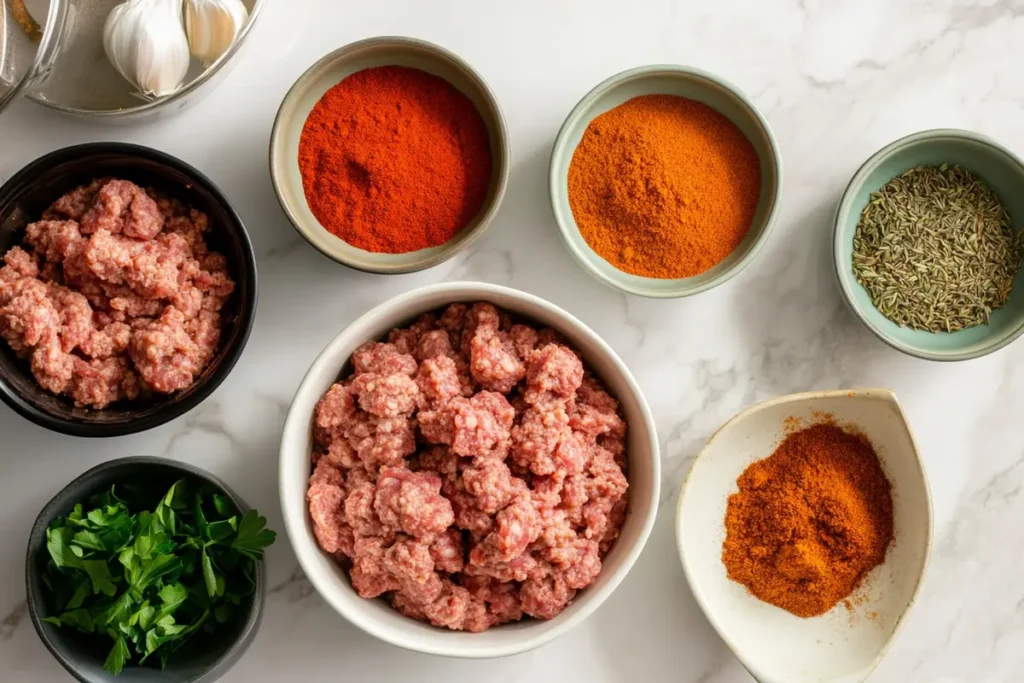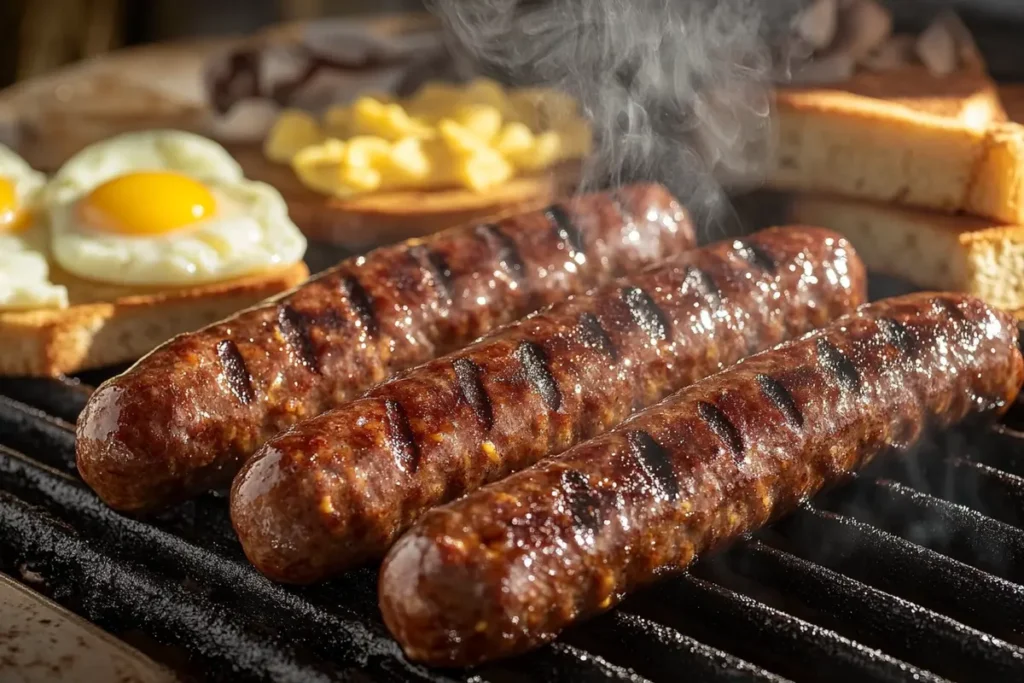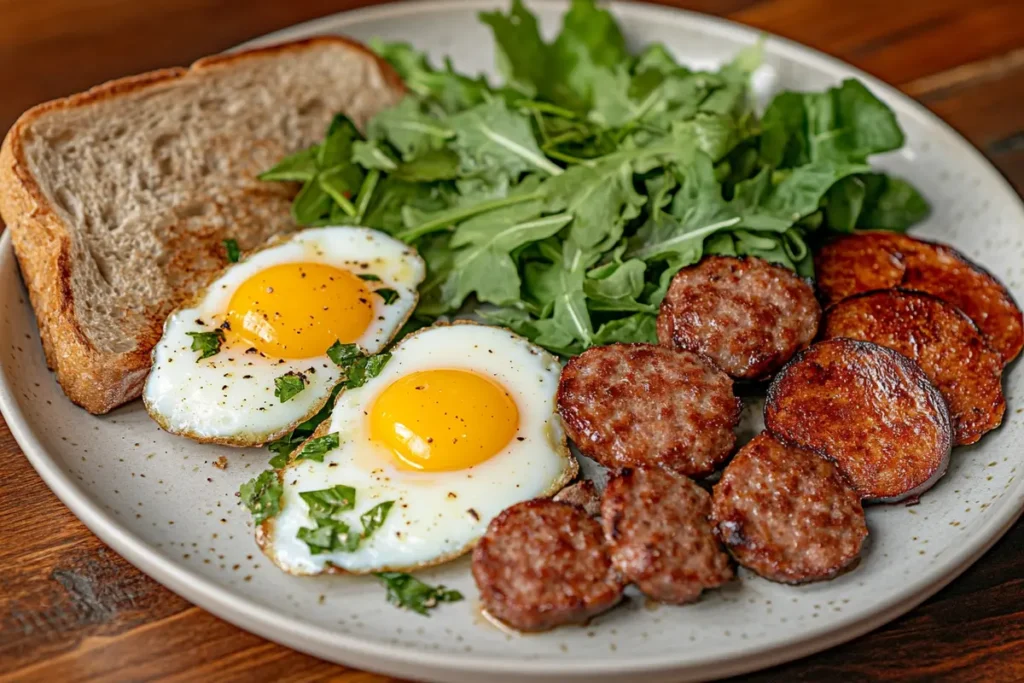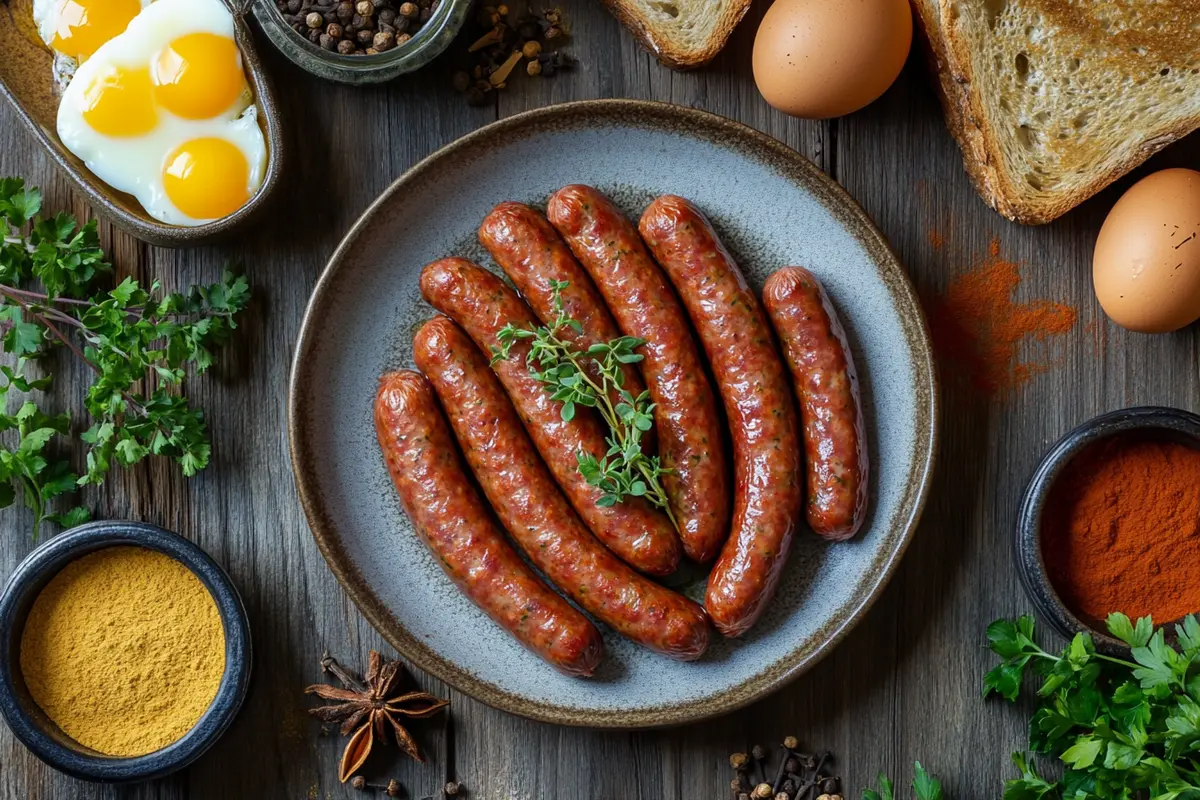Homemade venison breakfast sausage is more than just a tasty morning treat; it’s a celebration of rich flavors, personal creativity, and the joy of crafting something from scratch. This guide will take you through everything you need to know about making the perfect venison breakfast sausage recipe, from selecting the best cuts to storing the finished product. Let’s dive in!
Introduction to Venison Breakfast Sausage
What Makes Venison Special?
Venison is a lean, flavorful meat derived from deer, prized for its tender texture and deep, earthy taste. Unlike fattier meats like pork or beef, venison offers a healthier alternative while still delivering bold flavors that pair beautifully with traditional breakfast spices. If you’re looking for a protein-packed start to your day, venison breakfast sausage is an ideal choice.
Why Make Sausage at Home?
Let’s face it: store-bought sausages often come with additives, preservatives, and questionable ingredients. By making your own breakfast sausage with venison, you gain complete control over the flavors, fat content, and quality of ingredients. Plus, it’s a rewarding process that allows you to experiment and create a signature dish.
The Appeal of Venison for Breakfast
While venison might sound like an unconventional choice for breakfast, it’s surprisingly versatile. Its robust taste complements a variety of herbs and spices typically used in sausage making, such as sage, thyme, and black pepper. Paired with eggs, toast, or even a side of sautéed veggies, venison sausage transforms an ordinary breakfast into a gourmet experience.
Overview of the Recipe
This guide will cover the essentials of crafting a delicious venison breakfast sausage. You’ll learn about selecting the right cuts, creating a balanced fat ratio, seasoning to perfection, and even the best methods for cooking and serving your sausages. Whether you’re a novice in the kitchen or an experienced home cook, this recipe is designed to be approachable and foolproof.
Sourcing High-Quality Venison
The foundation of any great homemade venison sausage is the quality of the meat. Whether you’re using venison from a trusted butcher or meat harvested during hunting season, ensuring freshness is key. Venison should be deep red, with minimal connective tissue or sinew, to ensure tender, evenly textured sausages. If possible, look for ethically sourced or farmed options for the best results.
Understanding Venison and Its Culinary Uses
What Is Venison?
Venison refers to the meat derived from deer, and it’s known for its lean and rich profile. Unlike conventional meats, venison breakfast sausage recipe enthusiasts appreciate its unique gamey flavor that adds depth to dishes. This meat has been cherished for centuries and was once considered a delicacy for the upper class. Today, it’s enjoyed worldwide as a versatile and nutritious protein option.
Venison is typically sourced from wild or farm-raised deer, with cuts like the loin, shoulder, and leg being the most commonly used. Its lean quality makes it perfect for homemade venison breakfast sausage recipes, as it pairs beautifully with added fat and seasonings.
Nutritional Benefits of Venison
Why choose venison over traditional breakfast meats? For one, it’s a nutritional powerhouse! Venison is high in protein and low in saturated fat, making it a heart-healthy choice. It’s also rich in essential nutrients like iron, zinc, and B vitamins, which support energy production and overall well-being.
Compared to other meats, venison is significantly lower in cholesterol and calories. If you’re looking to cut down on processed meats without sacrificing flavor, incorporating wild game sausage recipes like this one into your diet is an excellent move.
Popular Venison Dishes Around the World
Venison’s appeal isn’t limited to breakfast sausages. Across the globe, cultures have embraced this meat in various ways:
- In Europe, venison is often used in hearty stews and roasts, paired with seasonal vegetables and herbs.
- In North America, it’s a staple in chili, burgers, and jerky, showcasing its adaptability to different flavors.
- In Asia, venison finds its way into spicy curries and stir-fries, bringing a bold twist to traditional dishes.
Its adaptability is what makes it so exciting for home cooks. From rich, slow-cooked meals to quick and easy breakfast dishes, venison adds an unmistakable touch of gourmet flair.
The Perfect Protein for Breakfast Sausage
When crafting venison sausage recipes, the meat’s natural leanness plays a crucial role. Unlike pork or beef, which contain more marbling, venison requires additional fat to achieve that juicy, tender sausage texture. By blending it with pork fat or another substitute, you can create a balanced flavor that still highlights venison’s distinct taste.
The Art of Making Venison Breakfast Sausage
Essential Equipment for Sausage Making
Making a perfect venison breakfast sausage recipe requires more than just great ingredients—you’ll need the right tools to bring it all together. Don’t worry; you don’t need a professional-grade kitchen. Here are the must-have items to get started:
- Meat Grinder: The cornerstone of sausage making, a grinder ensures a uniform texture. Manual or electric options work, but electric models are easier for beginners.
- Mixing Bowls: Large, sturdy bowls to mix your ground venison and seasoning evenly.
- Sausage Stuffer (Optional): While you can shape patties or cook crumbled sausage, a sausage stuffer allows you to make authentic sausage links.
- Sharp Knife: For trimming venison and cutting fat into smaller pieces.
- Kitchen Scale: Precision is key when balancing your meat-to-fat ratio, and a scale ensures consistency.
Keeping your equipment clean and cold is crucial. This helps maintain the integrity of the meat while reducing the risk of contamination. For more insights on equipment care, check out these meat grinder maintenance tips.

Selecting the Right Cuts of Venison
Not all venison cuts are created equal, especially when it comes to making sausage. The best cuts for homemade venison sausage are lean, flavorful, and free from sinew.
- Top Choices: Shoulder, neck, and hindquarters. These cuts are tender and grind well.
- Avoid: Cuts with heavy connective tissue, such as shanks, which can affect texture.
If your venison has been frozen, make sure it’s thawed properly in the refrigerator before grinding to preserve its quality.
Choosing the Ideal Fat Ratio
One of the biggest challenges with venison is its low fat content. While this is a nutritional advantage, fat is essential for making sausages juicy and flavorful. A good fat-to-meat ratio is about 80% meat to 20% fat. Pork fat is the most popular choice due to its neutral flavor and availability. However, if you’re avoiding pork, beef tallow or duck fat can be excellent alternatives.
When blending fat into the venison, make sure both are cold to prevent the fat from melting during grinding. Mix evenly to avoid dry spots in the sausage.
Flavorful Seasoning Blends for Breakfast Sausage
The spices you use can make or break your sausage. A classic breakfast sausage seasoning mix typically includes:
- Savory Herbs: Sage, thyme, and rosemary.
- Spices: Black pepper, red pepper flakes, and smoked paprika for a subtle kick.
- Sweet Notes: A touch of brown sugar or maple syrup enhances the flavor without overpowering it.
Feel free to experiment! Garlic, onion powder, and nutmeg are great additions that can add depth to your sausage.
Step-by-Step Guide to Preparing Venison Breakfast Sausage
- Trim the Meat: Remove any sinew, silver skin, or gristle from your venison.
- Grind the Meat: Using a cold grinder, alternate between venison and fat to ensure even distribution.
- Mix the Ingredients: Combine the ground meat, fat, and seasoning in a chilled mixing bowl. Use your hands to mix, but avoid overworking the meat.
- Shape the Sausages: Form into patties, crumbles, or use a sausage stuffer for links.
Pro Tip: Always cook a small test piece to adjust seasoning before forming the rest of the batch.
Cooking Methods for Venison Sausage
Venison breakfast sausage can be cooked in several ways, depending on your preference:
- Pan-Frying: Heat a skillet with a small amount of oil and cook the sausages over medium heat until browned.
- Grilling: Preheat the grill and cook sausages until they reach an internal temperature of 160°F.
- Baking: For a hands-off approach, bake sausages on a sheet pan at 375°F for 20-25 minutes.

Serving Suggestions and Pairings
Classic Breakfast Pairings
One of the best things about venison breakfast sausage is its versatility. Whether served as a standalone feature or paired with other breakfast staples, it’s a guaranteed hit. Here are some timeless combinations to elevate your morning meal:
- Eggs and Toast: The robust flavor of venison sausage complements scrambled eggs or sunny-side-up eggs. A slice of toasted sourdough or whole-grain bread rounds out the meal.
- Hash Browns: Crispy, golden hash browns add texture and contrast to the juicy sausage.
- Fresh Fruits: A side of berries, orange slices, or melon adds a refreshing sweetness to balance the savory sausage.
- Breakfast Bowls: Layer cooked sausage with quinoa, roasted sweet potatoes, and sautéed greens for a hearty, nutritious start to your day.

Creative Recipes Featuring Venison Sausage
If you’re looking to think outside the breakfast box, there are endless ways to incorporate venison breakfast sausage into other meals. Here are some unique ideas to spark your creativity:
- Sausage-Stuffed Bell Peppers: Hollow out bell peppers, fill them with cooked venison sausage, rice, and cheese, then bake until tender.
- Venison Sausage Breakfast Casserole: Combine sausage, eggs, cheese, and bread cubes in a casserole dish for a baked breakfast option that feeds a crowd.
- Sausage and Vegetable Stir-Fry: Toss crumbled venison sausage with your favorite veggies and a drizzle of soy sauce for a quick, savory lunch.
- Pasta with Sausage and Greens: Add cooked sausage to pasta with wilted spinach, olive oil, and a sprinkle of parmesan cheese for a simple yet satisfying dinner.
Why Pairing Matters
The bold flavors of venison sausage shine when paired with the right sides and dishes. Its rich, earthy taste needs complementary flavors that won’t overshadow it. Think crispy textures, creamy components, or fresh, bright accompaniments to create a balanced meal. Whether it’s a simple breakfast plate or a creative dinner recipe, pairing thoughtfully ensures every bite is memorable.
Storing and Preserving Homemade Sausage
Proper Storage Techniques
After putting time and effort into crafting the perfect venison breakfast sausage recipe, it’s essential to store it properly to maintain its flavor and safety. Following these tips will ensure your sausages remain fresh and ready to enjoy:
- Refrigeration: Store raw sausage in an airtight container or vacuum-sealed bag for up to three days in the refrigerator.
- Freezing: For longer storage, freeze uncooked sausages. Wrap them individually in plastic wrap and place them in a freezer-safe bag or container. Properly stored, they can last up to six months without compromising quality.
- Pre-Cooked Storage: Cooked venison sausages can be refrigerated for up to five days or frozen for two to three months. Allow them to cool completely before packaging.
Label your packages with dates to ensure you use the oldest sausages first, minimizing waste.
Safe Thawing and Reheating Practices
Thawing and reheating venison sausage the right way is crucial to preserving its taste and texture. Avoid quick fixes like microwaving raw sausages to defrost, as this can cause uneven thawing and compromise flavor.
- Thawing: Always thaw sausages in the refrigerator overnight for best results. If you’re in a hurry, place them in a sealed bag and submerge in cold water, changing the water every 30 minutes.
- Reheating Cooked Sausage: Use a skillet over low to medium heat to reheat pre-cooked sausages. Add a splash of water or stock to prevent them from drying out. Alternatively, you can reheat them in an oven at 300°F for 10-15 minutes.
By following these methods, you’ll maintain the juicy, tender qualities that make homemade venison sausage so enjoyable.
Preservation Tips for Freshness
To further enhance the longevity and flavor of your sausages:
- Avoid Freezer Burn: Ensure all air is removed from packaging before freezing.
- Use Wax Paper: If freezing multiple sausages together, separate them with wax paper to prevent sticking.
- Consider Curing: If you want an extended shelf life without freezing, curing your venison sausage is an excellent option. This involves adding salt and curing agents, then drying the sausages.
Frequently Asked Questions
What is the best fat ratio for venison sausage?
A balanced fat ratio is essential for creating juicy and flavorful sausage. The recommended ratio is 80% lean venison to 20% fat. Pork fat is a popular choice due to its neutral flavor and ease of blending with venison. However, beef tallow or duck fat can work as alternatives for those avoiding pork.
Can I make venison sausage without pork fat?
Absolutely! While pork fat is traditional, there are several alternatives for those with dietary restrictions when making a venison breakfast sausage recipe. Beef tallow, duck fat, or even olive oil can be used. Keep in mind that non-fat options may result in a slightly different texture, but proper seasoning and careful cooking can still deliver delicious results in your homemade venison breakfast sausage recipe.
How do I prevent my venison sausage from drying out?
Dry sausage is often a result of insufficient fat or overcooking. To prevent this:
- Ensure your fat ratio is adequate.
- Avoid overmixing the sausage mixture, which can break down the fat too much.
- Cook sausages over medium heat and remove them as soon as the internal temperature reaches 160°F.
What spices are traditionally used in breakfast sausage?
Classic breakfast sausage blends include sage, thyme, black pepper, garlic powder, and a touch of nutmeg. Adding red pepper flakes or smoked paprika introduces a hint of spice, while brown sugar or maple syrup brings a subtle sweetness. Feel free to adjust these seasonings to suit your taste!
How long can I store homemade venison sausage in the freezer?
When stored correctly in an airtight, freezer-safe bag, raw venison sausage can last up to six months in the freezer. Cooked sausages have a shorter shelf life of about two to three months. Always check for signs of freezer burn before use.
Can I use this recipe for other game meats?
Yes, this recipe is highly versatile and works beautifully with other game meats like elk, antelope, or moose. Simply adjust the seasoning to complement the unique flavors of the meat you’re using. Keep the fat ratio consistent to ensure optimal texture.
Embracing the Tradition of Homemade Venison Sausage
Why Homemade Venison Sausage Matters
Crafting your own venison breakfast sausage recipe is more than just cooking—it’s about creating something unique and meaningful. Homemade sausage lets you control the ingredients, experiment with flavors, and enjoy a healthier alternative to store-bought options. Plus, the satisfaction of making it yourself? Priceless.
A Tradition Worth Keeping
Homemade venison sausage connects you to the art of cooking from scratch. Whether it’s a weekend breakfast or a special family gathering, this dish brings people together. Once you master the basics, you can tweak flavors and textures, keeping this time-honored tradition alive in your kitchen.

